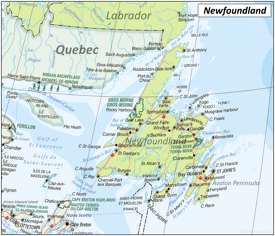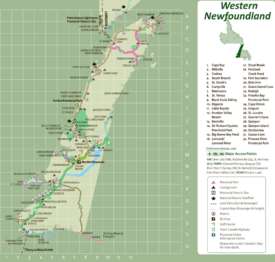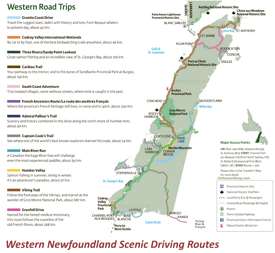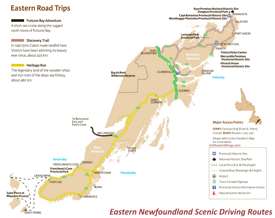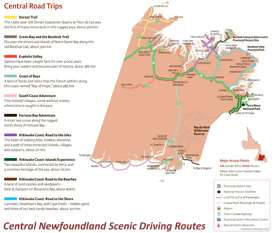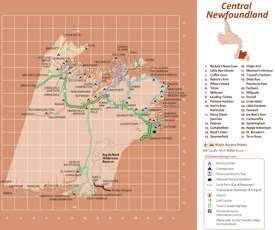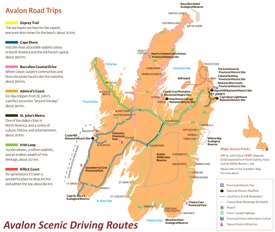Newfoundland Map
Description:
This map shows cities, towns, province capital, rivers, lakes, Trans-Canada highway, and major roads in Newfoundland.
Size: 1000x860px / 376 Kb
Author: Ontheworldmap.com
You may download, print or use the above map for educational, personal and non-commercial purposes. Attribution is required. For any website, blog, scientific research or e-book, you must place a hyperlink (to this page) with an attribution next to the image used.
Maps of Newfoundland
Maps of Avalon Peninsula
About Newfoundland
Newfoundland is a large island located off the east coast of North America and constitutes the insular portion of the Canadian province of Newfoundland and Labrador. It is the world's 16th-largest island, covering an area of approximately 108,860 square kilometers. The island is separated from Labrador by the Strait of Belle Isle and from Cape Breton Island by the Cabot Strait.
Geography
Newfoundland is roughly triangular in shape, extending approximately 400 kilometers from north to south and 500 kilometers from east to west at its widest point. The coastline is highly irregular, characterized by numerous bays, fjords, and peninsulas. Major bays include Trinity Bay, Conception Bay, Placentia Bay, and the Bay of Islands.
The island's topography consists primarily of a plateau that rises gradually from the coastal areas, with elevations generally between 300 and 600 meters. The Long Range Mountains along the west coast represent an extension of the Appalachian Mountain system and contain the island's highest point, the Lewis Hills, at approximately 814 meters above sea level. The interior features extensive boreal forests, numerous lakes including Grand Lake, the largest lake in Newfoundland, and extensive wetlands and barrens.
The island sits on the northeastern section of the North American continental shelf. The geology is complex and ancient, with rocks dating back to the Precambrian era. The Gros Morne National Park on the west coast is a UNESCO World Heritage Site renowned for exposing portions of the Earth's mantle and demonstrating plate tectonics.
Climate and Natural Environment
Newfoundland experiences a cool maritime climate strongly influenced by the surrounding ocean waters. The Labrador Current, which flows southward along the coast, brings cold Arctic water and icebergs, particularly during spring and early summer. This maritime influence moderates temperatures but also contributes to frequent fog, high precipitation, and unpredictable weather conditions.
Average temperatures range from approximately -5°C in winter to 15°C in summer, though significant variations occur across different parts of the island. The south coast and Avalon Peninsula generally experience milder winters than the northern regions. Annual precipitation is substantial, often exceeding 1,400 millimeters, with considerable snowfall in winter.
The island supports diverse wildlife, including black bears, caribou, moose, red foxes, and numerous bird species. Moose were introduced to the island in 1904 and have since become abundant. The waters surrounding Newfoundland are rich in marine life and support populations of whales, seals, and various fish species.
Population and Settlements
Approximately 520,000 people live on the island of Newfoundland, representing about 94 percent of the province's total population. Settlement patterns reflect the historical importance of the fishing industry, with numerous small communities distributed along the coast. The capital city, St. John's, located on the Avalon Peninsula, is the largest urban center with a metropolitan population of over 200,000.
Other significant population centers include Mount Pearl, Conception Bay South, Corner Brook on the west coast, and Grand Falls-Windsor in the interior. Many outport communities, small coastal settlements that developed around fishing stations, have experienced population decline and abandonment since the collapse of the cod fishery in 1992. The provincial government initiated controversial resettlement programs beginning in the 1950s to consolidate populations in larger centers.
History
The island was originally inhabited by indigenous peoples for thousands of years. The Beothuk were the indigenous people of Newfoundland at the time of European contact, though they became extinct in the 19th century due to disease, displacement, and conflict. The Mi'kmaq, originally from the mainland, also established a presence on the island.
Norse explorers led by Leif Erikson established a settlement at L'Anse aux Meadows around 1000 CE, making it the earliest known European settlement in North America. However, this settlement was short-lived. European activity intensified in the late 15th and early 16th centuries when John Cabot reached the island in 1497. Subsequently, seasonal fishing operations by English, French, Spanish, and Portuguese fishermen became common.
Permanent European settlement began in earnest in the 17th century, primarily by English and Irish settlers. The island became a British colony and developed a unique culture influenced by its isolation and maritime heritage. Control of the island and fishing rights were contested between England and France until the Treaty of Utrecht in 1713 and subsequent agreements established British sovereignty, though France retained fishing rights on portions of the coast and sovereignty over Saint-Pierre and Miquelon.
Economy and Resources
For centuries, the economy of Newfoundland was dominated by the Atlantic cod fishery. The abundance of cod on the Grand Banks made the island a center of the fishing industry. However, overfishing led to the collapse of cod stocks and a moratorium on cod fishing was imposed in 1992, devastating the economy and leading to significant outmigration.
The economy has since diversified significantly. Offshore oil and gas production has become a major industry, with several large projects operating on the Grand Banks. The Hibernia, Terra Nova, White Rose, and Hebron oil fields have made the province a significant petroleum producer. Aquaculture, particularly Atlantic salmon farming, has grown substantially. Manufacturing, tourism, and technology sectors have also expanded, though challenges remain in creating economic opportunities outside the capital region.
The Facts:
| Largest city: | St. John's |
| Population: | 520,000 |
| Area: | 42,030 sq mi (108,860 sq km) |
| Density: | 11.37/sq mi (4.39/sq km) |
| Coordinates: | 48°32′30″N 56°07′30″W |
| Time zone: |
Newfoundland Standard Time (UTC-03:30) - Summer (DST) Newfoundland Daylight Time (UTC-02:30) |
| Ethnic groups: | English, Irish, Scottish, French, and Mi'kmaq |
Google Map of Newfoundland
Main sights in Newfoundland
- Signal Hill National Historic Site
- Cape Spear Lighthouse
- Gros Morne National Park
- L'Anse aux Meadows National Historic Site
- Iceberg Alley
- The Rooms
- Fogo Island
- Twillingate
- Witless Bay Ecological Reserve
- Western Brook Pond
- Tablelands
- Cape St. Mary's Ecological Reserve
- Terra Nova National Park
- St. John's Harbour
- George Street
- Bonavista Lighthouse
- Red Bay National Historic Site
- Battle Harbour
- Johnson GEO CENTRE
- Quidi Vidi Village
- Trinity
- Ferryland Lighthouse
- Mistaken Point Ecological Reserve
- Petty Harbour
- Castle Hill National Historic Site
- Bay Bulls
- Torngat Mountains National Park
- Cupids
- Port au Choix National Historic Site
- Salvage
Maps of Canada
Provinces and Territories
Cities of Canada
Cities of Canada


